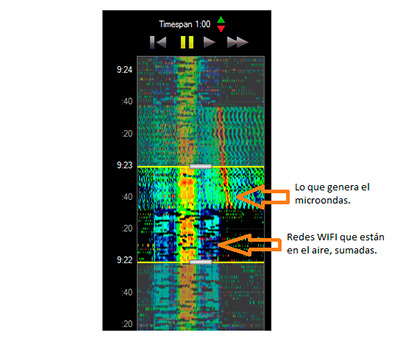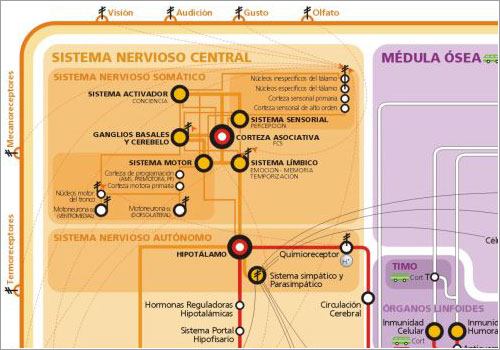
Total Pageviews
Monday 19 August 2013
Ubuntu Edge May Have Just Set the Crowdfunding Record

Connecting Cape Town: Inside South Africa's TV white spaces experiment

Skype for Outlook.com preview now available in the US

IRL: Nook Simple Touch with GlowLight and the PowerPlant portable battery pack

Sony Xperia Z Ultra review: the best phone you'll probably never buy

The gold iPhone is a done deal, says AllThingsD

Microsoft announces 50-game Xbox One lineup, with more titles to come

Oculus Rift's John Carmack working on mobile SDK support first, coming soon

Jim Jannard steps down, hands the Red Camera reins to Jarred Land

Tesco rumored to launch its own tablet, hopes you'll add one to the shopping list

Engadget's back to school guide 2013: HDTV

Microondas + WiFi ~ interferencias
Leonardo nos contó que estaba haciendo algunas pruebas en casa con un analizador de espectro profesional en dos bandas (2,4 y 5 GHz) e hizo algunos gráficos que permiten hacerse una idea de las interferencias que producen a veces los electrodomésticos en el espectro de 2,4 GHz, que es el que también utiliza el Wi-Fi para comunicar ordenadores, routers, etcétera.
(Clic en las imágenes para ampliar.)

Este experimento fue realizado con un microondas, poniéndolo en marcha durante un minuto más o menos. Importante: la experiencia en cada hogar puede ser un poco diferente, especialmente según esté el aislamiento de los aparatos, su antigüedad, calidad, etcétera.
En mi casa por ejemplo el microondas funciona bien y no interfiere con nada, pero cuando hay otros chismes, como por ejemplo un afilalápices eléctrico de esos del «todo a 100» que interfieren con la señal de la TDT, que deja degrada notablemente la imagen.
¡El maravilloso mundo de las ondas electromagnéticas!
via Microsiervos http://www.microsiervos.com/archivo/tecnologia/microondas-wifi-interferencias.html
Avances en publicidad: del pago por clic al pago por mirada
 Según Phys.org Google estaría preparando un sistema con el que sabría cuándo alguien mira un anuncio en Internet o en el MundoReal™
Según Phys.org Google estaría preparando un sistema con el que sabría cuándo alguien mira un anuncio en Internet o en el MundoReal™
Sería algo parecido al actual modelo publicitario de «pago por clic» en el que el anunciante paga cuando alguien pulsa en un banner, pero en este caso contaría cada vez que alguien lo mira.
«Hasta la fecha, según la patente, el seguimiento ocular se limita prácticamente a investigación sobre el comportamiento [por ejemplo, de los usuarios que utilizan un sitio web] porque es fiable pero también es poco discreto y muy costoso. Un método similar pero que sea discreto y poco costoso puede tener numerosas aplicaciones diarias.»La utilidad para Google sería cobrar a sus anunciantes según el número de veces que un anuncio es visto por personas que utilizan [dispositivos como las gafas] Google Glass, sean anuncios online u offline. La patente de Google hace referencia a un sistema de publicidad de «pago por mirada».
Foto (CC) Antonio Zugaldia.
via Microsiervos http://www.microsiervos.com/archivo/tecnologia/del-pago-por-clic-al-pago-por-mirada.html
30 Ways Google Glass Can Innovate the Classroom

Next Amazon Kindle Fire HD Specs May Include 2560 x 1600 Display

Report: Samsung's 12-Inch Tablet Coming in October

LastPass Passwords Exposed for Some Internet Explorer Users

What to expect when you're expecting Gamescom 2013

Find and share the best Oculus Rift games on Oculus Share, now in beta

TrekkSoft Raises $800K To Help Tour Providers Promote, Manage And Sell Their Tours

TrekkSoft, the Swiss startup that primarily offers a B2B solution to enable tour and other activity providers to promote, manage and sell their tours online, offline and on mobile, has raised a $800,000 seed round.
The new funding, which adds to the $200,000 previously pumped into the startup by its founders while bootstrapping the company, comes from Redalpine Capital II, the Innovation Fund of Schwyzer Kantonalbank, and a group of private investors, including Armin Meier, former CEO of Kuoni, Walter Güntensperger, CEO of Active Travel and former CEO of Hotelplan Switzerland, and Adrian Locher, founder and COO of DeinDeal.ch. Locher and Redalpine Capital’s Markus Oswald join TrekkSoft’s board of directors.
Founded in 2010 and fully launched in 2012, TrekkSoft targets Tour & Activity suppliers — which it notes is the largest segment in the travel industry after flights and hotels, and worth over $90 billion per year — with a SaaS solution to help them manage their prices, capacity and sales channels from one platform. It offers features such as real-time, online bookings of live inventory both online and in-destination via mobile devices.
At first glance, TrekkSoft competes with an array of tour marketplace solutions, such as GetYourGuide, Peek, Viator etc., although these focus more on B2C and distribution. Instead, the startup is attacking the B2B end of the market by giving tour suppliers a solution that ensures their live inventory is directly bookable on their own website/app, and accessible to re-sellers and marketplaces. In this respect, its competitors include Rezgo.com, TourCMS, Bookeo.com, and Xola.com, “although Excel, the telephone and pencil and paper, and home made sign-up forms can all be considered significant competitors as well”, says TrekkSoft co-founder and CEO Jonathan Fauver.
More broadly, TrekkSoft is talking up the market opportunity as a whole, claiming that less than 15% of tour companies have an online sales presence and even fewer have a mobile solution. “It is a fragmented, low-tech industry with the majority of the “live” product inventory not available in real time,” adds Fauver.
Additional functionality offered by TrekkSoft’s B2B solution includes an integrated payment gateway, tour management software, and a CMS with a suite of promotional tools including social media integration, and agent tracking. “We also package in a free mobile optimized website and/or white labeled app,” says Fauver. Meanwhile, the TrekkSoft Partner network also allows suppliers in the TrekkSoft eco-system to seamlessly cross-sell each other’s products either directly or via an API.
For tour and activity providers, TrekkSoft is free at sign-up, with no fixed fees, or set-up costs, offering unlimited user accounts and unlimited bookings. Instead it charges 6% plus a .50c transaction fee on any online booking, which includes credit card and PSP fees. All offline reservations and bookings — i.e. those where payment isn’t processed via TrekkSoft — are free of charge, such as POS bookings, telephone reservations, direct payment on arrival etc.
TrekkSoft says it currently hosts a live inventory of over 3,000 trips supplied by more than 200 companies worldwide and has processed 600,000 bookings to date. It will use the fresh injection of capital to expand its booking solution to new destinations and onboard new accounts quicker, as well as further develop its technology both on desktop and mobile. It also plans on staffing up its Sales & Marketing office in New York, which it opened just over a year ago, to “focus on high volume destinations for U.S. and European consumers such as the Caribbean, Mexico and South Florida”.
via TechCrunch » Startups http://feedproxy.google.com/~r/techcrunch/startups/~3/J0CLXcGfK6I/
Wii U now allows eShop purchases from within indie games and ported apps

La fisiología del cuerpo humano como un mapa de metro

Esta no es más que la esquina superior de un gráfico que explica en forma de mapa de metro lo principal de la fisiología del cuerpo humano.
En su forma original, incluida en el libro «Bases fisiológicas de la práctica médica» de Mario Dvorkin, Romina Romano y Eduardo Mercovich, ocupa por lo visto ocho páginas de 55×80 cm, pero aún viéndolo en esta versión reducida no deja de ser impresionante.
Tal y como se puede leer en Mapa callejero del funcionamiento del cuerpo humano se puede ver cómo se conectan unos sistemas con otros, las hormonas salen representadas como autobuses que los conectan, mientras que las glándulas son las estaciones de partida y llegada; es un puntazo que los fagocitos sean la policía.
(Vía @alpoma).
via Microsiervos http://www.microsiervos.com/archivo/ciencia/fisiologia-cuerpo-humano-como-mapa-de-metro.html
YC-Backed Teleborder Wants To Use Tech Smarts And SaaS To Cut Through Work Visa Red Tape

While immigration reform continues to be a hot topic of contention in the U.S., Teleborder, a new startup that’s part of the current batch of YC companies, has developed a service that aims to tackle another aspect of the issue: the immense amount of red tape that companies have to go through once they do decide to employ someone from outside the U.S.
The problem, says co-founder and CEO James Richards, is that when it comes to work visas, while a lot of companies are keen to bring in top talent to fill vacant positions, even when the U.S. immigration authorities have created channels for them to do so, it’s time-consuming to gather together the different documents needed, and very easy to get it wrong, get the application rejected, and then have to start again.
Teleborder has come up with a way to distill the process so that the documents are gathered and tracked online, and verified to make sure all the right boxes are checked (so to speak), taking some of the human error out of the process and taking on some of the bureaucratic burden itself. The solution is sold to businesses themselves — based on the fact that most permit applications need to be initiated by them at this point. In future, he says this may change to also cover individuals applying for permits.
Getting work visas for non U.S. citizens is a problem that has wide applicability in the U.S. alone, where each year up to 140,000 people from outside the U.S. are granted permanent work permits for special skills; that’s not counting the thousands who are granted temporary work permits.
“Whether you are bringing on a chef or an engineer, all companies have to go through the same process. It’s a generic issue,” Richards tells me. That said, he says that Teleborder has been already working with a number of tech companies first, partly because that’s the most immediate industry around them, and partly because “they have been most receptive to this early on.”
“Tech companies tend to be highly leveraged,” he says. “Companies like Google can make millions of dollars per engineer, so they tend to search everywhere for talent and have the most acute need for us.” And when the company in question is a startup, it could be staffing up fast, and often without large HR departments to handle that workload. (Google, he notes, handles up to 1,000 work visa applications annually.)
Richards says it’s already been working with a number of tech companies as paying customers; it will be revealing their names during the YC demo day later this week.
There is another advantage to working first with tech companies: the rate of adoption. Richard notes that in general the biggest obstacle for adoption has been getting companies to put Teleborder into their work flows. “It’s like asking them to adopt another piece of CRM software,” he says. Other competitors in the space include LawLogix and INSzoom, but these are really designed (and priced) for lawyers rather than directly for HR professionals. “It’s like using a forklift when all you really wanted was a cart,” he says.
Richards himself has had a first-hand taste of what it’s like to go through immigration hoops. He is the son of a UK national father and Indonesian mother. His father was an executive in the hotel industry and so his family moved to a number of different countries as Richards grew up. “He’s a great example of the person we want to enable,” he says. “We have all these expats working everywhere and every time you need to move somewhere you need to go through this process. It’s time someone enabled a world without borders for work.”
Richards himself has studied in a number of countries, and holds, among other qualifications, qualifications to practice law in New York. (He’s in the U.S. on an E-3 visa for Australians). While originally Teleborder was accepted to the YC program as a one-stop, SaaS platform for all kinds of legal services, he and his co-founders (Michael Smith, Michael Hendrickx and Ikhsan Maulana — all also from outside the U.S.) all decided to narrow the focus for now, and given their collective backgrounds — and the pressing nature of this issue in particular in the tech industry — work visas was the direction they decided to take their business.
Beyond helping manage active work permit applications, Teleborder has come up with some services that extend the product beyond those peaks: businesses are able to enter the details of employees who already have temporary permits, and then Teleborder will track those on a calendar and remind HR of when they are about to expire. All of this sits alongside existing applications in an all-in-one dashboard so that HR can track everything in a single place.
As for pricing, Richards says that using Teleborder is free for those who are using it to track visa expirations for existing employees. The charges kick in once Teleborder starts helping you to compile an application, say for an H-1B visa. He says that based on the type of visa that is being applied for, the price can be between $5,000 and $10,000, which includes not just using Teleborder’s software platform, but also a look-over by immigration lawyers for a final check.
Richards says that this pricing, in fact, can be a 15%-25% premium on companies electing to do this themselves, but less expensive than hiring a legal firm. Most importantly, it’s time-saving (up to 80% less time on applications, Teleborder has found), and helps avoid what he describes as “the highest level of distraction.”
Longer term, Teleborder has ambitions to take their software platform and make it usable outside the U.S. to tap into the wider movement of people to jobs worldwide. “We make it easy to bring a programmer from India to Dublin, CA, but we also want to make it easy to make it easy also for that same person to get to Dublin, Ireland. We want to be the main HR system for all visa-related employee management. Right now immigration is a political issue, and banking is a process, but if you focus just on the exchange of information, it doesn’t have to be.”
via TechCrunch » Startups http://feedproxy.google.com/~r/techcrunch/startups/~3/QEr3IVH8tP4/
What Age of Empires Online says about Steam's impact on free-to-play games

5 Must-Have Tools for a Killer Presentation

Samsung Monster Phone, the Galaxy Mega, Arriving in U.S.

Apple's Next iPhone Could Come in Gold

Oppo R819 hands-on (video)

Twitter nabs former Google media ad sales chief to push TV and movie expansion

How Do You Connect 10 Million Dumbphone Users To Facebook?

As low internet penetration stifled Facebook’s early growth in emerging markets in 2011, Indian startup U2opia developed an SMS-like system for users to post messages and read notifications by navigating through various menus via their keypad. Now, the analogue technology is being used by 10 million mobile subscribers in emerging markets, and boasts a million new sign-ups every month. However, the startup risks making itself redundant if it doesn’t grow with its increasingly digital user base.
Indian startup U2opia worked closely with Facebook to develop an app based on the first-generation technology, USSD (unstructured supplementary service data). It leverages the carrier’s GSM systems to create a data session connecting Facebook’s systems and the phone user. Subscribers dial *325# to access numbered menus that allow them to read their news feed, update their status or post on their wall, and approve friend requests, all in real-time.
Launched on 17 May 2011, the fledgling startup would have to wait another ten months before reaching the million-user milestone, according to founder Sumesh Menon, but in the next 13 months it added another 9 million, and is now signing another million every month. Users pay about $1 a month for unlimited access to the service, but the telcos take the vast majority of this (In India, carriers typically take about 70 percent of the cut in these types of deals.) U2opia’s customers are spread across 25 countries which access the service via 40 carriers. In Africa, Facebook for USSD is how 80 percent of users access the social network.
“What we did was find a simple, inexpensive, made-for-mobile solution that was handset agnostic,” Menon said. “We looked at the lowest common denominator and realised there was a massively untapped potential base for working with poor infrastructure. We tried addressing these specific market issues.”
According to the International Telecommunications Union between 2010 and 2012 internet penetration doubled in India to about 12%; it more than doubled in Kenya to 32%; and grew by 10 percent in Brazil, spanning half the population.
There is obviously room to grow in these markets and Menon also has plans to expand in Eastern Europe, but admits the service doesn’t translate to internet-rich developed countries such as the US and the UK.
He understands the importance of developing a new business model to keep pace with his aspirational user base, who will ditch U2opia’s service and simply upgrade to Facebook’s app once they get their first job and buy their first smartphone. This is only a matter of time in these developing economies. His investors Matrix Partners, who tipped in an undisclosed amount in September 2011, will be closely watching.
Menon is beefing up his 100-strong workers with engineers to launch new apps that will focus on meeting new people.
“In some of these countries we’re adding more users than when we first launched however, we do want to address the issue of graduating users,” Menon said. “We’re piloting a different bouquet of products altogether. Something in development right now is around meeting new people and connecting with people based on their interest and conversation, rather than clear-cut dating app.”That’s something we’re evaluating because as these users mature and get into serious relationship mode, it starts to become relevant to connect to people with a different perspective.”
via TechCrunch » Startups http://feedproxy.google.com/~r/techcrunch/startups/~3/vOYWjS4c11s/

